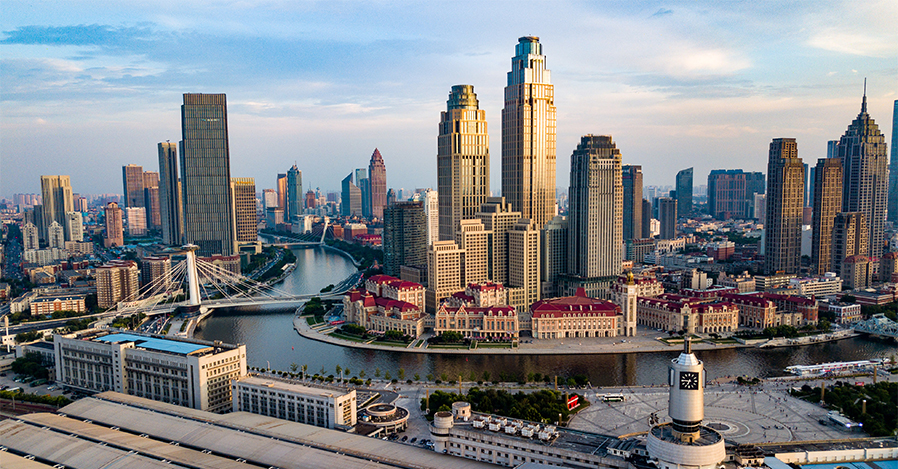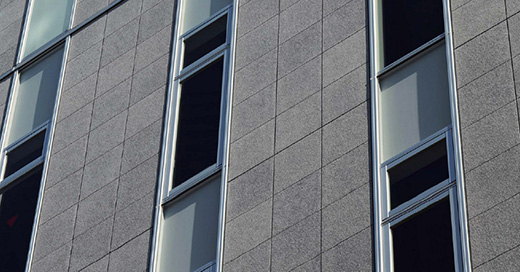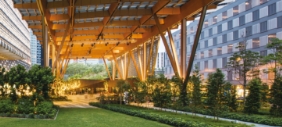2024.04.10 Architecture

Sustainable Architecture Around the World Part 2
Breath-taking beauty and unprecedented distinctive architecture have long been highly esteemed as "masterpieces". However, in recent years, buildings have come to be evaluated not only based on their design, but also on their sustainability.
According to the World Green Building Council in 2019, approximately 39% of the world's carbon emissions are related to the construction and building industry, with 28% being emitted through building operation such as air conditioning and electricity usage, and the remaining 11% being emitted through materials and construction.
To reduce such environmental burdens, various approaches to sustainable architecture have been undertaken, including the selection of building materials, construction methods, and effective utilization of energy and water resources. Furthermore, in addition to reducing environmental impact, sustainable architecture aims to solve issues such as providing habitat for living things and creating employment opportunities in economically disadvantaged areas, and strives to harmonize with the surrounding environment and solve problems.
Sustainable architecture is often evaluated based on the following three points.
Environmental Consideration
Sustainable architecture emphasizes minimizing the impact on the natural environment during the construction process and the use of buildings. Examples include the use of renewable energy, the implementation of energy-saving equipment, and waste recycling.
Social Aspects
Sustainable architecture gives priority to the health and comfort of residents or users. Considerations include residents' health, contribution to the local community, and the use of public spaces.
Economic Aspects
Sustainable architecture is required to be economically sustainable as well. Reduction of energy costs, efficient use of construction materials, and the development of long-term maintenance plans are important.
In the column, we will gradually introduce some famous examples of sustainable architecture from around the world.
10. Amager Bakke Apartments
- Environmental
- Economic
One typical example of architecture that pursues sustainability is the "Amager Bakke Apartments" located in Copenhagen, Denmark. The buildings are designed to balance environmental considerations and residents' comfort. Firstly, solar panels are installed on the rooftop to maximize the utilization of renewable energy. Additionally, the use of high-performance insulation materials and energy-efficient facilities minimizes energy consumption.
Inside the buildings, initiatives promoting waste recycling and reuse are actively implemented. Moreover, green rooftops and garden spaces are provided to promote urban greening and CO2 absorption. Furthermore, the buildings' design incorporates features such as maximizing natural light and ensuring pathways for airflow, considering residents' health and quality of life.
The "Amager Bakke Apartments" have received international acclaim as an outstanding example of sustainable architecture.
11. One Central Park
- Environmental
- Economic
One example of sustainable architecture is the "One Central Park" located in Sydney, Australia. This building is attracting attention as a model case combining environmental considerations with innovative design. Firstly, the building's exterior features a green facade abundant with plants, aiming to protect the ecosystem in the urban environment. Additionally, there is a vast public garden on the rooftop to promote CO2 absorption and urban greening. Furthermore, the utilization of renewable energy sources such as solar panels and wind power is actively promoted, ensuring that the building itself utilizes sustainable energy sources.
Inside the building, high-performance insulation materials and energy-efficient facilities are used to optimize energy consumption. Additionally, sustainable resource management such as water reuse and waste recycling is emphasized. "One Central Park" is praised worldwide as a pioneering example of sustainable architecture.
12. De Ceuvel
- Environmental
The typical example of sustainable architecture is "De Ceuvel" located in Amsterdam, Netherlands. This building is a complex that renovated old warehouses, and its commitment to sustainability stands out prominently. Firstly, "De Ceuvel" maximizes the utilization of renewable energy by installing solar panels on its roof. Additionally, within the building, LED lighting and high-performance insulation materials are utilized to ensure efficient energy usage. Measures to enhance energy efficiency, such as implementing heat recovery systems and introducing green roofs, are actively implemented. Moreover, "De Ceuvel" promotes waste recycling and water reuse to minimize environmental impact. Furthermore, it emphasizes collaboration with the local community and fulfilling social responsibilities. It is highly evaluated as a sustainable architecture both environmentally and socially.
13. Seattle Building
- Environmental
- Economic
A typical example of sustainable architecture is the "Seattle Building" located in Malmo, Sweden. This building is characterized by its emphasis on utilizing renewable energy and environmental consideration. First, solar panels are installed on the roof to supply a portion of the electricity used in the building from renewable sources. Additionally, high-performance insulation materials and double or triple-glazed windows are used to improve insulation performance and contribute to reducing heating and cooling costs. Inside the building, energy-efficient facilities and LED lighting are introduced to minimize energy waste. Furthermore, measures such as waste sorting and recycling, as well as the introduction of water-saving facilities, are actively implemented to reduce environmental impact. In addition, interactions with neighboring communities and contributions to the local community are also highly valued. The "Seattle Building" has received high praise as a model case of environmentally friendly sustainable architecture.
14. BLOXHUB
- Environmental
- Economic
An exceptionally outstanding example of sustainable architecture is the "BLOXHUB" located in Copenhagen, Denmark. As part of an urban redevelopment project, this building combines sustainability with innovative design. The "BLOXHUB" features environmentally conscious design such as the use of renewable energy, waste minimization, and urban greening. Solar panels are installed on the building to promote the use of renewable energy. Moreover, high-performance insulation materials and energy-saving facilities are used to improve energy efficiency. Additionally, the building includes extensive rooftop gardens and public spaces, aiming to enhance urban greening and promote the health of residents. Measures such as waste recycling and water reuse are actively implemented to minimize environmental impact. The “BLOXHUB” has attracted international attention as a typical example of sustainable architecture that pursues harmony between the environment and the city.
15. Sino-Singapore Tianjin Eco-city
- Environmental
A notable example of sustainable architecture is the "Sino-Singapore Tianjin Eco-city" located in Beijing, China. It is a national project for environmental urban development jointly promoted by China and Singapore. The buildings incorporate innovative approaches as part of an environmentally friendly urban development project. The "Sino-Singapore Tianjin Eco-city" implements a wide range of initiatives to achieve sustainable urban living, including the use of renewable energy, recycling of waste, and urban greening. Inside the buildings, renewable energy sources such as solar panels and wind power are actively utilized to achieve energy self-sufficiency. Additionally, the efficient use of energy has been achieved through the introduction of high-performance insulation materials and energy-saving equipment. Furthermore, efforts such as waste recycling, water reuse, and the increase of green spaces within the city are promoted to reduce environmental impact. The "Sino-Singapore Tianjin Eco-city" is attracting attention around the world as a model of sustainable urban development.
*Our various products were used for hotel, commercial facility, residential buildings, factory, etc. at "Sino-Singapore Tianjin Eco-city".
16. Nordvita Nordstrom
- Environmental
- Social
A remarkable example of sustainable architecture is the "Nordvita Nordstrom" located in Stockholm, Sweden. The building is designed to provide high levels of comfort while minimizing environmental impact. Firstly, high-performance insulation materials are used for the exterior to maximize insulation performance. Additionally, solar panels are installed on the roof to promote the use of renewable energy. Inside the building, LED lighting and high-efficiency heating and cooling systems are installed to minimize energy waste. Active efforts are made for waste recycling and water reuse to minimize environmental impact. The building’s design has adopted measures considering the health and quality of life of residents, such as utilizing natural light and ensuring ventilation. The “Nordvita Nordstorm” has received international acclaim as an outstanding example of sustainable and comfortable architecture.
17. Brooklyn Arts Tower
- Environmental
- Economic
A notable example of sustainable architecture is the "Brooklyn Arts Tower" located in Seattle, USA. This building is characterized by environmentally conscious design, incorporating many principles of sustainability. Firstly, the building places emphasis on the use of renewable energy, utilizing solar panels and wind turbines. Additionally, high-performance insulation materials and energy-efficient systems are used to minimize energy consumption. Inside the building, active efforts are made for waste recycling and water reuse, reducing environmental impact. Furthermore, there are gardens and green spaces on the rooftop to promote urban greening and CO2 absorption. Moreover, in the building's design, consideration is given to maximizing natural light and optimizing ventilation to enhance residents' comfort. The "Brooklyn Arts Tower" has garnered worldwide attention as a model of sustainable architecture.
18. Commonwealth Place
- Environmental
- Social
A prominent example of sustainable architecture is "Commonwealth Place" located in Melbourne, Australia. This building combines environmental considerations with innovative design, serving as a model for sustainable urban development. “Commonwealth Place” minimizes energy consumption by using high-performance insulation materials and windows, LED lighting, and energy-saving facilities. Furthermore, the building itself has the ability to generate its own energy through the utilization of renewable energy sources such as solar panels and wind power. Inside the building, initiatives like waste recycling and water reuse contribute to reducing environmental impact. Additionally, the surrounding area has excellent access to public transportation, as well as bicycle parking and charging stations. “Commonwealth Place” has received international acclaim as a prime example of architecture that balances sustainability and comfort.
19. Bosarge Family Education Center
- Environmental
- Social
"Bosarge Family Education Center" is a globally renowned example of sustainability located in North Carolina, United States. The sustainability features of this building are diverse. Firstly, the building is constructed using abundant natural materials, incorporating environmentally friendly building materials. Materials such as wood, stone, and clay are actively used to create a sustainable architecture that takes advantage of local resources. Additionally, measures have been taken to maximize the building's insulation and reduce energy waste, including highly insulated walls and roofs, and high-performance windows. Furthermore, solar panels are installed on the roof to promote the use of renewable energy. Inside the building, energy-efficient equipment and LED lighting have been introduced to minimize energy consumption. Moreover, initiatives such as water reuse and waste recycling are implemented to support sustainable living. “Bosarge Family Education Center” is considered a global model for sustainable architecture, harmonizing with nature.
Column categories
Access Ranking
Portal categories
Access Ranking

Functional
2024.02.28
Fair-Faced Concrete and Sustainability - Open up New Possibilities of Fair-Faced Concrete -

Material
2023.01.20
What are the advantages of expressing with a textured product instead of using natural stone?

Functional
2023.12.01
Relationship Between Paints and Sustainability

Functional
2024.01.29
Functionality and Sustainability 1 -Stop Dirt & Stains on Exterior Wall! -

Material
2024.04.03
Rich Colours and Designs Are the Key! -Sustainable Design-

Material
2023.12.11



